rGO/GO Nanosheets in Tribology: From the State of the Art to the Future Prospective
Abstract
:1. Introduction
2. Nanoadditives in Tribology: rGO/GO Lubricant Additive
2.1. Nanoadditives Tribological Mechanism
2.1.1. Ball Bearings Effect
2.1.2. Protective/Tribofilm Formation
2.1.3. Mending/Repairing Effect
2.1.4. The Polishing/Smoothing Effect
2.2. rGO/GO Lubrication Mechanism
rGO/GO Behavior in Different Lubrication Conditions
3. Nanoadditives in Tribology: The Critical Aspects
3.1. Optimum Concentration
3.2. Nanosuspensions: Stability Factors
3.2.1. rGO/GO Suspension Stabilization Techniques
3.2.2. Dispersing Agents
3.2.3. rGO/GO Surface Modification and Functionalization Routes
3.2.4. Description of the Stability Methods for Dispersion in Lubricant Base Oils
4. Discussion
5. Conclusions
Author Contributions
Funding
Conflicts of Interest
References
- Bowden, F.P.; Gregory, J.N.; Tabor, D. Lubrication of metal surfaces by fatty acids. Nature 1945, 156, 97–101. [Google Scholar]
- Spikes, H. The history and mechanisms of ZDDP. Tribol. Lett. 2004, 17, 469–489. [Google Scholar]
- Forbes, E.S. Antiwear and extreme pressure additives for lubricants. Tribology 1970, 3, 145–152. [Google Scholar]
- Sudeep, P.M.; Taha-Tijerina, J.; Ajayan, P.M.; Narayanan, T.N.; Anantharaman, M.R. Nanofluids based on fluorinated graphene oxide for efficient thermal management. RSC Adv. 2014, 4, 24887–24892. [Google Scholar]
- Taha-Tijerina, J.; Aviña, K.; Diabb, J.M. Tribological and Thermal Transport Performance of SiO2-Based Natural Lubricants. Lubricants 2019, 7, 71. [Google Scholar]
- Bakunin, V.N.; Suslov, A.Y.; Kuzmina, G.N.; Parenago, O.P.; Topchiev, A.V. Synthesis and application of inorganic nanoparticles as lubricant components—A review. J. Nanopart. Res. 2004, 6, 273–284. [Google Scholar]
- Zhang, W.; Demydov, D.; Jahan, M.P.; Mistry, K.; Erdemir, A.; Malshe, A.P. Fundamental understanding of the tribological and thermal behavior of Ag–MoS2 nanoparticle-based multi-component lubricating system. Wear 2012, 288, 9–16. [Google Scholar]
- Jiao, D.; Zheng, S.; Wang, Y.; Guan, R.; Cao, B. The tribology properties of alumina/silica composite nanoparticles as lubricant additives. Appl. Surf. Sci. 2011, 257, 5720–5725. [Google Scholar]
- Sarno, M.; Senatore, A.; Cirillo, C.; Petrone, V.; Ciambelli, P. Oil lubricant tribological behaviour improvement through dispersion of few layer graphene oxide. J. Nanosci. Nanotechnol. 2014, 14, 4960–4968. [Google Scholar]
- Spikes, H. Friction modifier additives. Tribol. Lett. 2015, 60, 5. [Google Scholar]
- Seiler, S.; Halbig, C.E.; Grote, F.; Rietsch, P.; Börrnert, F.; Kaiser, U.; Meyer, B.; Eigler, S. Effect of friction on oxidative graphite intercalation and high-quality graphene formation. Nat. Commun. 2018, 9, 836. [Google Scholar] [PubMed] [Green Version]
- Konios, D.; Stylianakis, M.M.; Stratakis, E.; Kymakis, E. Dispersion behaviour of graphene oxide and reduced graphene oxide. J. Colloid Interface Sci. 2014, 430, 108–112. [Google Scholar]
- Pei, S.; Cheng, H.M. The reduction of graphene oxide. Carbon 2012, 50, 3210–3228. [Google Scholar]
- Li, J.; Zeng, X.; Ren, T.; Van der Heide, E. The preparation of graphene oxide and its derivatives and their application in bio-tribological systems. Lubricants 2014, 2, 137–161. [Google Scholar]
- Lee, C.; Wei, X.; Kysar, J.W.; Hone, J. Measurement of the elastic properties and intrinsic strength of monolayer graphene. Science 2008, 321, 385–388. [Google Scholar]
- Berman, D.; Erdemir, A.; Sumant, A.V. Graphene: A new emerging lubricant. Mater. Today 2014, 17, 31–42. [Google Scholar]
- Van, N.H. Effect of long-chain alkylamine on the dispersibility and tribological properties of alkyl-graphene in lubricant oil. Vietnam J. Sci. Technol. 2018, 56, 163–173. [Google Scholar]
- Geim, A.K. Graphene: Status and prospects. Science 2009, 324, 1530–1534. [Google Scholar]
- Schiøtz, J.; Jacobsen, K.W. A maximum in the streght of nanocrystalline copper. Science 2003, 301, 1357–1359. [Google Scholar]
- Lin, J.; Wang, L.; Chen, G. Modification of graphene platelets and their tribological properties as a lubricant additive. Tribol. Lett. 2011, 41, 209–215. [Google Scholar]
- Kim, D.; Archer, L.A. Nanoscale organic-inorganic hybrid lubricants. Langmuir 2011, 27, 3083–3094. [Google Scholar] [PubMed]
- Yu, F.; Chen, Y.; Liang, X.; Xu, J.; Lee, C.; Liang, Q.; Tao, P.; Deng, T. Dispersion stability of thermal nanofluids. Prog. Nat. Sci. Mater. 2017, 27, 531–542. [Google Scholar]
- Qin, Z.; Taylor, M.; Hwang, M.; Bertoldi, K.; Buehler, M.J. Effect of wrinkles on the surface area of graphene: Toward the design of nanoelectronics. Nano Lett. 2014, 14, 6520–6525. [Google Scholar]
- Shen, J.; Hu, Y.; Li, C.; Qin, C.; Ye, M. Synthesis of amphiphilic graphene nanoplatelets. Small 2009, 5, 82–85. [Google Scholar] [PubMed]
- Yu, H.L.; Yi, X.U.; Shi, P.J.; Xu, B.S.; Wang, X.L.; Qian, L.I.U. Tribological properties and lubricating mechanisms of Cu nanoparticles in lubricant. Trans. Nonferr. Metals Soc. 2008, 18, 636–641. [Google Scholar]
- Tomala, A.; Vengudusamy, B.; Ripoll, M.R.; Suarez, A.N.; Remškar, M.; Rosentsveig, R. Interaction between selected MoS2 nanoparticles and ZDDP tribofilms. Tribol. Lett. 2015, 59, 26. [Google Scholar]
- Viesca, J.L.; Battez, A.H.; González, R.; Chou, R.; Cabello, J.J. Antiwear properties of carbon-coated copper nanoparticles used as an additive to a polyalphaolefin. Tribol. Int. 2011, 44, 829–833. [Google Scholar]
- Sayuti, M.; Erh, O.M.; Sarhan, A.A.; Hamdi, M. Investigation on the morphology of the machined surface in end milling of aerospace AL6061-T6 for novel uses of SiO2 nanolubrication system. J. Clean. Prod. 2014, 66, 655–663. [Google Scholar]
- Liu, G.; Li, X.; Qin, B.; Xing, D.; Guo, Y.; Fan, R. Investigation of the mending effect and mechanism of copper nano-particles on a tribologically stressed surface. Tribol. Lett. 2004, 17, 961–966. [Google Scholar]
- Tao, X.; Jiazheng, Z.; Kang, X. The ball-bearing effect of diamond nanoparticles as an oil additive. J. Phys. D Appl. Phys. 1996, 29, 2932. [Google Scholar]
- Dassenoy, F. Application I: Nanolubricants. In Nanosciences and Nanotechnology: Evolution or Revolution? 1st ed.; Lourtioz, J.M., Lahmani, M., Dupas-Haeberlin, C., Hesto, P., Eds.; Springer: Cham, Switzerland, 2015; Volume 2, pp. 175–181. [Google Scholar]
- Gulzar, M.; Masjuki, H.H.; Kalam, M.A.; Varman, M.; Zulkifli, N.W.M.; Mufti, R.A.; Zahid, R. Tribological performance of nanoparticles as lubricating oil additives. J. Nanopart. Res. 2016, 18, 223. [Google Scholar]
- Laad, M.; Jatti, V.K.S. Titanium oxide nanoparticles as additives in engine oil. J. King Saud Univ. Sci. 2018, 30, 116–122. [Google Scholar]
- Khadem, M.; Penkov, O.V.; Pukha, V.E.; Maleyev, M.V.; Kim, D.E. Ultra-thin carbon-based nanocomposite coatings for superior wear resistance under lubrication with nano-diamond additives. RSC Adv. 2016, 6, 56918–56929. [Google Scholar]
- Padgurskas, J.; Rukuiza, R.; Prosyčevas, I.; Kreivaitis, R. Tribological properties of lubricant additives of Fe, Cu and Co nanoparticles. Tribol. Int. 2013, 60, 224–232. [Google Scholar]
- Demas, N.G.; Timofeeva, E.V.; Routbort, J.L.; Fenske, G.R. Tribological effects of BN and MoS2 nanoparticles added to polyalphaolefin oil in piston skirt/cylinder liner tests. Tribol. Lett. 2012, 47, 91–102. [Google Scholar]
- Nallasamy, P.; Saravanakumar, N.; Nagendran, S.; Suriya, E.M.; Yashwant, D. Tribological investigations on MoS2-based nanolubricant for machine tool slideways. Proc. Inst. Mech. Eng. 2015, 229, 559–567. [Google Scholar]
- Wu, L.; Zhang, Y.; Yang, G.; Zhang, S.; Yu, L.; Zhang, P. Tribological properties of oleic acid-modified zinc oxide nanoparticles as the lubricant additive in poly-alpha olefin and diisooctyl sebacate base oils. RSC Adv. 2016, 6, 69836–69844. [Google Scholar]
- Chen, Y.; Zhang, Y.; Zhang, S.; Yu, L.; Zhang, P.; Zhang, Z. Preparation of nickel-based nanolubricants via a facile in situ one-step route and investigation of their tribological properties. Tribol. Lett. 2013, 51, 73–83. [Google Scholar]
- Wu, J.F.; Zhai, W.S.; Jie, G.F. Preparation and tribological properties of WS2 nanoparticles modified by trioctylamine. Proc. Inst. Mech. Eng. 2009, 223, 695–703. [Google Scholar]
- Jifen, W.; Wensheng, Z.; Guifen, J. Preparation and tribological properties of tungsten disulfide hollow spheres assisted by methyltrioctylammonium chloride. Tribol. Int. 2010, 43, 1650–1658. [Google Scholar]
- Flores-Castañeda, M.; Camps, E.; Camacho-López, M.; Muhl, S.; García, E.; Figueroa, M. Bismuth nanoparticles synthesized by laser ablation in lubricant oils for tribological tests. J. Alloys Compd. 2015, 643, 67–70. [Google Scholar]
- Kato, H.; Komai, K. Tribofilm formation and mild wear by tribo-sintering of nanometer-sized oxide particles on rubbing steel surfaces. Wear 2007, 262, 36–41. [Google Scholar]
- Zhao, F.; Bai, Z.; Fu, Y.; Zhao, D.; Yan, C. Tribological properties of serpentine, La(OH)3 and their composite particles as lubricant additives. Wear 2012, 288, 72–77. [Google Scholar]
- Song, X.; Zheng, S.; Zhang, J.; Li, W.; Chen, Q.; Cao, B. Synthesis of monodispersed ZnAl2O4 nanoparticles and their tribology properties as lubricant additives. Mater. Res. Bull. 2012, 47, 4305–4310. [Google Scholar]
- Grierson, D.S.; Carpick, R.W. Nanotribology of carbon-based materials. Nano Today 2007, 2, 12–21. [Google Scholar]
- Ali, M.K.A.; Xianju, H.; Turkson, R.F.; Peng, Z.; Chen, X. Enhancing the thermophysical properties and tribological behaviour of engine oils using nano-lubricant additives. RSC Adv. 2016, 6, 77913–77924. [Google Scholar]
- Lee, C.G.; Hwang, Y.J.; Choi, Y.M.; Lee, J.K.; Choi, C.; Oh, J.M. A study on the tribological characteristics of graphite nano lubricants. Int. J. Precis. Eng. Manuf. 2009, 10, 85–90. [Google Scholar]
- Abdullah, M.I.H.C.; Abdollah, M.F.B.; Amiruddin, H.; Tamaldin, N.; Nuri, N.M. Effect of hBN/Al2O3 nanoparticle additives on the tribological performance of engine oil. J. Qual. Technol. 2014, 66, 1–6. [Google Scholar]
- Xu, Y.; Peng, Y.; Dearn, K.D.; Zheng, X.; Yao, L.; Hu, X. Synergistic lubricating behaviors of graphene and MoS2 dispersed in esterified bio-oil for steel/steel contact. Wear 2015, 342, 297–309. [Google Scholar]
- Eswaraiah, V.; Sankaranarayanan, V.; Ramaprabhu, S. Graphene-based engine oil nanofluids for tribological applications. ACS Appl. Mater. Interfaces 2011, 3, 4221–4227. [Google Scholar]
- Zhang, W.; Zhou, M.; Zhu, H.; Tian, Y.; Wang, K.; Wei, J.; Ji, F.; Li, X.; Li, Z.; Zhang, P.; et al. Tribological properties of oleic acid-modified graphene as lubricant oil additives. J. Phys. D Appl. Phys. 2011, 44, 20. [Google Scholar]
- Mungse, H.P.; Khatri, O.P. Chemically functionalized reduced graphene oxide as a novel material for reduction of friction and wear. J. Phys. Chem. C 2014, 118, 14394–14402. [Google Scholar]
- Kim, K.S.; Lee, H.J.; Lee, C.; Lee, S.K.; Jang, H.; Ahn, J.H.; Kim, J.H.; Lee, H.J. Chemical vapor deposition-grown graphene: The thinnest solid lubricant. ACS Nano 2011, 5, 5107–5114. [Google Scholar]
- Berman, D.; Erdemir, A.; Sumant, A.V. Few layer graphene to reduce wear and friction on sliding steel surfaces. Carbon 2013, 54, 454–459. [Google Scholar]
- Mungse, H.P.; Kumar, N.; Khatri, O.P. Synthesis, dispersion and lubrication potential of basal plane functionalized alkylated graphene nanosheets. RSC Adv. 2015, 5, 25565–25571. [Google Scholar]
- Bart, J.C.; Gucciardi, E.; Cavallaro, S. Biolubricants: Science and Technology, 1st ed.; Woodhead Publishing: Cambridge, UK, 2013; pp. 13–15. [Google Scholar]
- Patel, J.; Kiani, A. Effects of Reduced Graphene Oxide (rGO) at Different Concentrations on Tribological Properties of Liquid Base Lubricants. Lubricants 2019, 7, 11. [Google Scholar]
- Liñeira del Río, J.M.; López, E.R.; Fernández, J.; García, F. Tribological properties of dispersions based on reduced graphene oxide sheets and trimethylolpropane trioleate or PAO 40 oils. J. Mol. Liquids 2019, 274, 568–576. [Google Scholar]
- Gupta, B.N.; Kumar, N.; Panda, K.; Dash, S.; Tyagi, A.K. Energy efficient reduced graphene oxide additives: Mechanism of effective lubrication and antiwear properties. Sci. Rep. 2016, 6, 18372. [Google Scholar]
- Ismail, N.A.; Bagheri, S. Lube Oil Wear Reduction via Organic Tribofilms. Lubricants 2017, 5, 30. [Google Scholar]
- Li, Y.; Zhao, J.; Tang, C.; He, Y.; Wang, Y.; Chen, J.; Mao, J.; Zhou, Q.; Wang, B.; Wei, F.; et al. Highly Exfoliated Reduced Graphite Oxide Powders as Efficient Lubricant Oil Additives. Adv. Mater. Interfaces 2016, 3, 1600700. [Google Scholar]
- Schlüter, B.; Mülhaupt, R.; Kailer, A. Synthesis and Tribological Characterization of Stable Dispersions of Thermally Reduced Graphite Oxide. Tribol. Lett. 2014, 53, 353–363. [Google Scholar]
- Mungse, P.H.; Gupta, K.; Singh, R.; Sharma, O.P.; Sugimura, H.; Khatri, O.P. Alkylated graphene oxide and reduced graphene oxide: Grafting density, dispersion stability to enhancement of lubrication properties. J. Colloid Interface Sci. 2019, 541, 150–162. [Google Scholar]
- Aldana, P.U. Tungsten disulfide nanoparticles as lubricant additives for the automotive industry. Ph.D. Thesis, Université de Lyon, Lyon, France, 2016. [Google Scholar]
- Yu, W.; Xie, H. A review on nanofluids: Preparation, stability mechanisms, and applications. J. Nanomater. 2012, 2012, 17. [Google Scholar]
- Zhao, J.; Li, Y.; Wang, Y.; Mao, J.; He, Y.; Luo, J. Mild thermal reduction of graphene oxide as a lubrication additive for friction and wear reduction. RSC Adv. 2017, 7, 1766–1770. [Google Scholar]
- Ismail, N.A.; Bagheri, S. Highly oil-dispersed functionalized reduced graphene oxide nanosheets as lube oil friction modifier. Mater. Sci. Eng. B Adv. 2017, 222, 34–42. [Google Scholar]
- Ota, J.; Hait, S.K.; Sastry, M.I.S.; Ramakumar, S.S.V. Graphene dispersion in hydrocarbon medium and its application in lubricant technology. RSC Adv. 2015, 5, 53326–53332. [Google Scholar]
- Ali, M.K.A.; Xianjun, H.; Abdelkareem, M.A.; Gulzar, M.; Elsheikh, A.H. Novel approach of the graphene nanolubricant for energy saving via anti-friction/wear in automobile engines. Tribol. Int. 2018, 124, 209–229. [Google Scholar]
- Dou, X.; Koltonow, A.R.; He, X.; Jang, H.D.; Wang, Q.; Chung, Y.W.; Huang, J. Self-dispersed crumpled graphene balls in oil for friction and wear reduction. Proc. Natl. Acad. Sci. USA 2016, 113, 1528–1533. [Google Scholar]
- Overview of DLVO Theory. Available online: http://www.colloid.ch/index.php?name=dlvo (accessed on 5 January 2020).
- Minami, I. Molecular science of lubricant additives. Appl. Sci. 2017, 7, 445. [Google Scholar]
- Stankovich, S.; Dikin, D.A.; Piner, R.D.; Kohlhaas, K.A.; Kleinhammes, A.; Jia, Y.; Wu, Y.; Nguyen, S.T.; Ruoff, R.S. Synthesis of graphene-based nanosheets via chemical reduction of exfoliated graphite oxide. Carbon 2007, 45, 1558–1565. [Google Scholar]
- Lonkar, S.P.; Abdala, A.A. Applications of graphene in catalysis. J. Thermodyn. Catal. 2014, 5, 1–132. [Google Scholar]
- Jeon, I.Y.; Chang, D.W.; Kumar, N.A.; Baek, J.B. Functionalization of carbon nanotubes. In Carbon Nanotubes-Polymer Nanocomposites, 1st ed.; Yellampalli, S., Ed.; IntechOpen: Shanghai, China, 2011; pp. 91–109. [Google Scholar]
- Grimme, S. Do special noncovalent π–π stacking interactions really exist? Angew. Chem. 2008, 47, 3430–3434. [Google Scholar]
- Wang, H.; Chen, Z.; Xin, L.; Cui, J.; Zhao, S.; Yan, Y. Synthesis of pyrene-capped polystyrene by free radical polymerization and its application in direct exfoliation of graphite into graphene nanosheets. J. Polym. Sci. 2015, 53, 2175–2185. [Google Scholar]
- Popescu, M.T.; Tasis, D.; Tsitsilianis, C. Ionizable star copolymer-assisted graphene phase transfer between immiscible liquids: Organic solvent/water/ionic liquid. ACS Macro Lett. 2014, 3, 981–984. [Google Scholar]
- Karachevtsev, V.A.; Glamazda, A.Y.; Plokhotnichenko, A.M.; Leontiev, V.S.; Linnik, A.S. Comparative study on protection properties of anionic surfactants (SDS, SDBS) and DNA covering of single-walled carbon nanotubes against pH influence: Luminescence and absorption spectroscopy study. Mater. Sci. Eng. C 2011, 42, 41–46. [Google Scholar]
- Song, Y.; Lee, H.; Ko, J.; Ryu, J.; Kim, M.; Sohn, D. Preparation and characterization of surfactant-exfoliated graphene. J. Korean Chem. Soc. 2014, 35, 2009. [Google Scholar]
- Gallivan, J.P.; Dougherty, D.A. Cation-π interactions in structural biology. Proc. Natl. Acad. Sci. USA 1999, 96, 9459–9464. [Google Scholar]
- Jeong, S.Y.; Kim, S.H.; Han, J.T.; Jeong, H.J.; Jeong, S.Y.; Lee, G.W. Highly concentrated and conductive reduced graphene oxide nanosheets by monovalent cation–π interaction: Toward printed electronics. Adv. Funct. Mater. 2012, 22, 3307–3314. [Google Scholar]
- Hou, S.; Su, S.; Kasner, M.L.; Shah, P.; Patel, K.; Madarang, C.J. Formation of highly stable dispersions of silane-functionalized reduced graphene oxide. Chem. Phys. 2010, 501, 68–74. [Google Scholar]
- Park, J.S.; Na, H.K.; Min, D.H.; Kim, D.E. Desorption of single-stranded nucleic acids from graphene oxide by disruption of hydrogen bonding. Analyst 2013, 138, 1745–1749. [Google Scholar]
- Wang, G.; Shen, X.; Wang, B.; Yao, J.; Park, J. Synthesis and characterisation of hydrophilic and organophilic graphene nanosheets. Carbon 2009, 47, 1359–1364. [Google Scholar]
- Thomas, H.R.; Marsden, A.J.; Walker, M.; Wilson, N.R.; Rourke, J.P. Sulfur-Functionalized Graphene Oxide by Epoxide Ring-Opening. Angew. Chem. 2014, 53, 7613–7618. [Google Scholar]
- Pham, T.A.; Choi, B.C.; Jeong, Y.T. Facile covalent immobilization of cadmium sulfide quantum dots on graphene oxide nanosheets: Preparation, characterization, and optical properties. Nanotechnology 2010, 21, 465603. [Google Scholar] [PubMed]
- Choudhary, S.; Mungse, H.P.; Khatri, O.P. Dispersion of alkylated graphene in organic solvents and its potential for lubrication applications. J. Mater. Chem. 2012, 22, 21032–21039. [Google Scholar]
- Di Crescenzo, A.; Di Profio, P.; Siani, G.; Zappacosta, R.; Fontana, A. Optimizing the interactions of surfactants with graphitic surfaces and clathrate hydrates. Langmuir 2016, 32, 6559–6570. [Google Scholar]
- Hsieh, A.G.; Punckt, C.; Korkut, S.; Aksay, I.A. Adsorption of sodium dodecyl sulfate on functionalized graphene measured by conductometric titration. J. Phys. Chem. B 2013, 117, 7950–7958. [Google Scholar]
- Achari, A.; Datta, K.K.R.; De, M.; Dravid, V.P.; Eswaramoorthy, M. Amphiphilic aminoclay–RGO hybrids: A simple strategy to disperse a high concentration of RGO in water. Nanoscale 2013, 5, 5316–5320. [Google Scholar]
- Ye, M.; Cai, T.; Shang, W.; Zhao, L.; Zhang, Y.; Liu, D.; Liu, S. Friction-induced transfer of carbon quantum dots on the interface: Microscopic and spectroscopic studies on the role of inorganic–organic hybrid nanoparticles as multifunctional additive for enhanced lubrication. Tribol. Int. 2018, 127, 557–567. [Google Scholar]
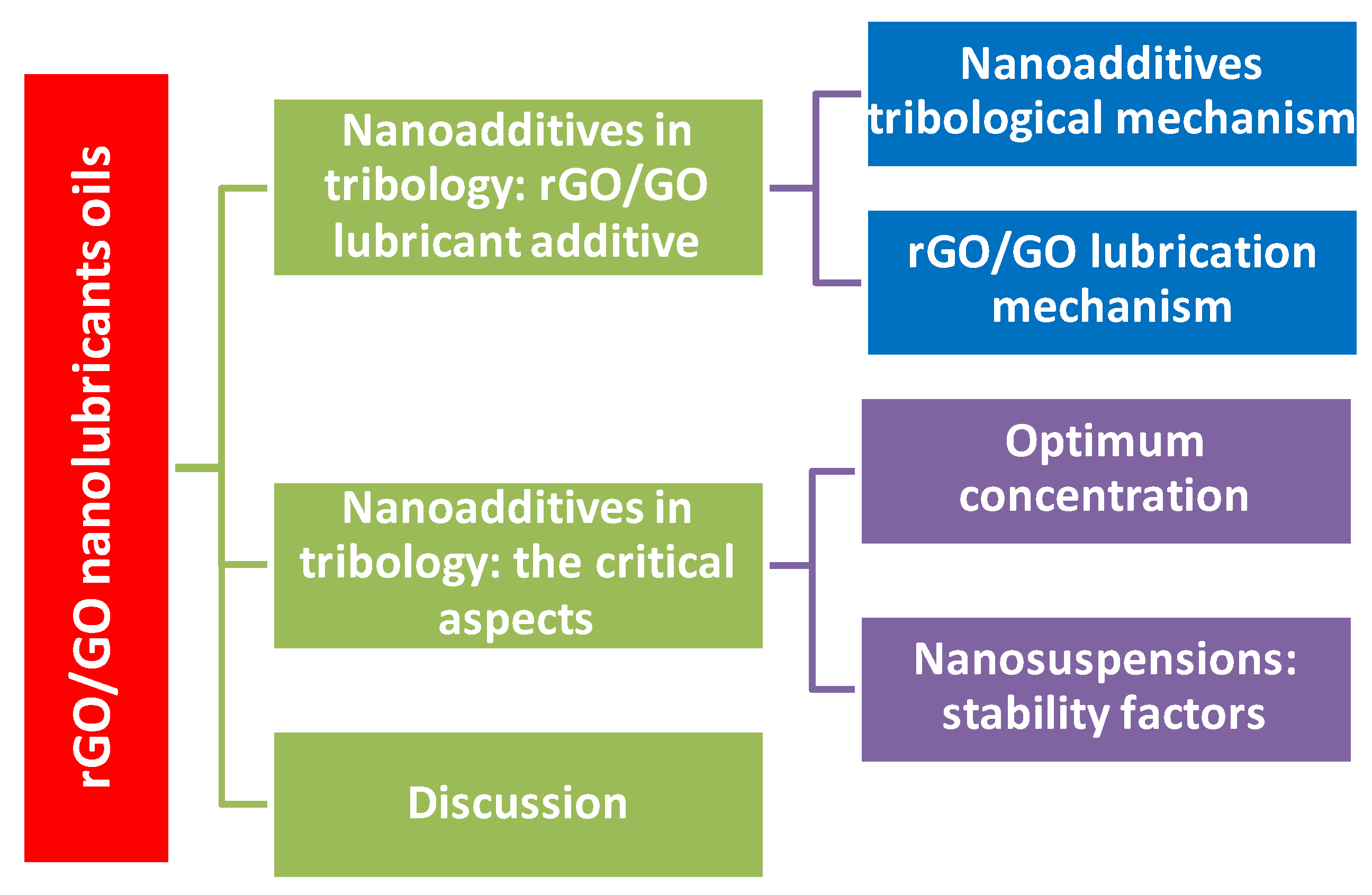

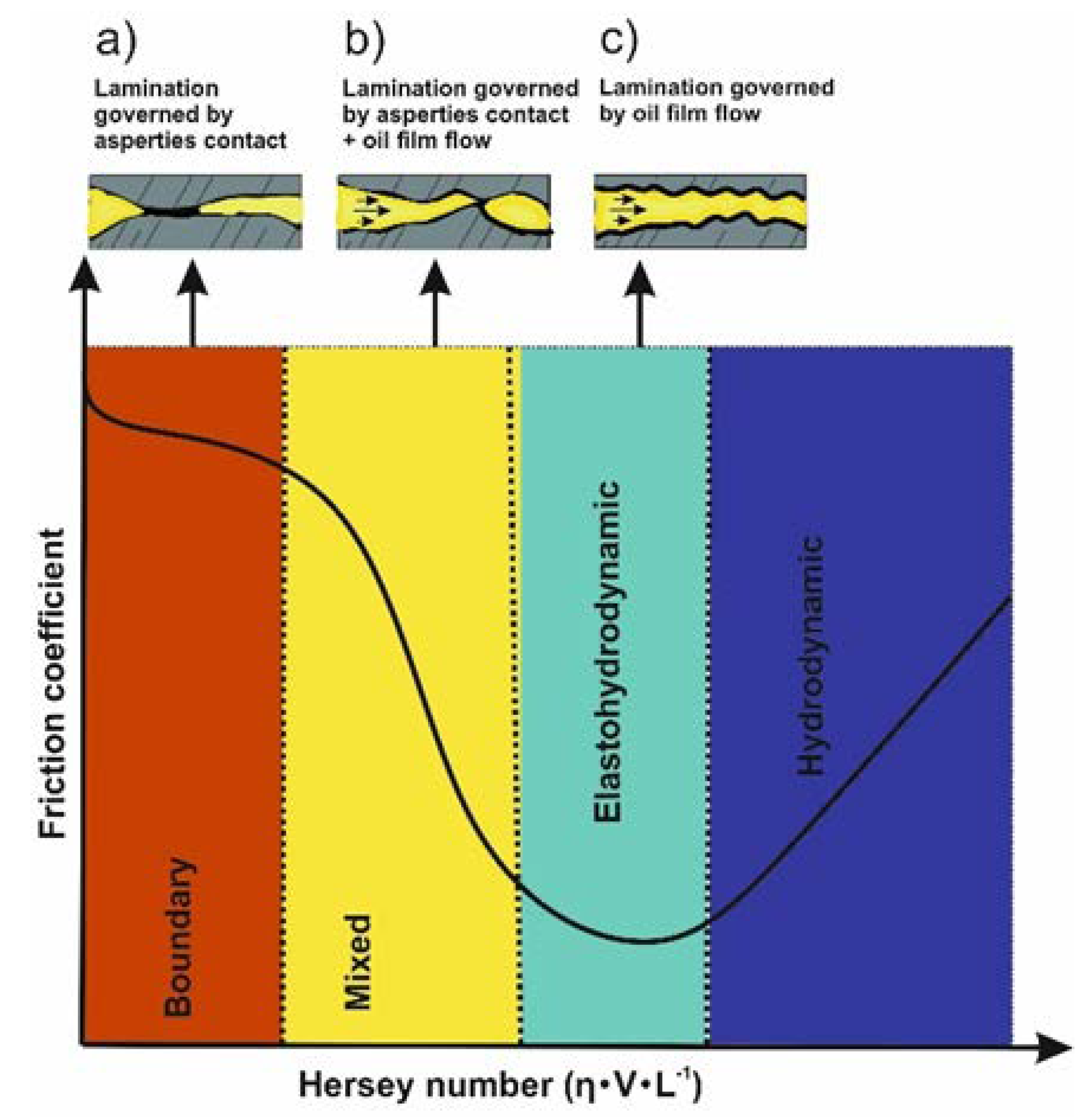
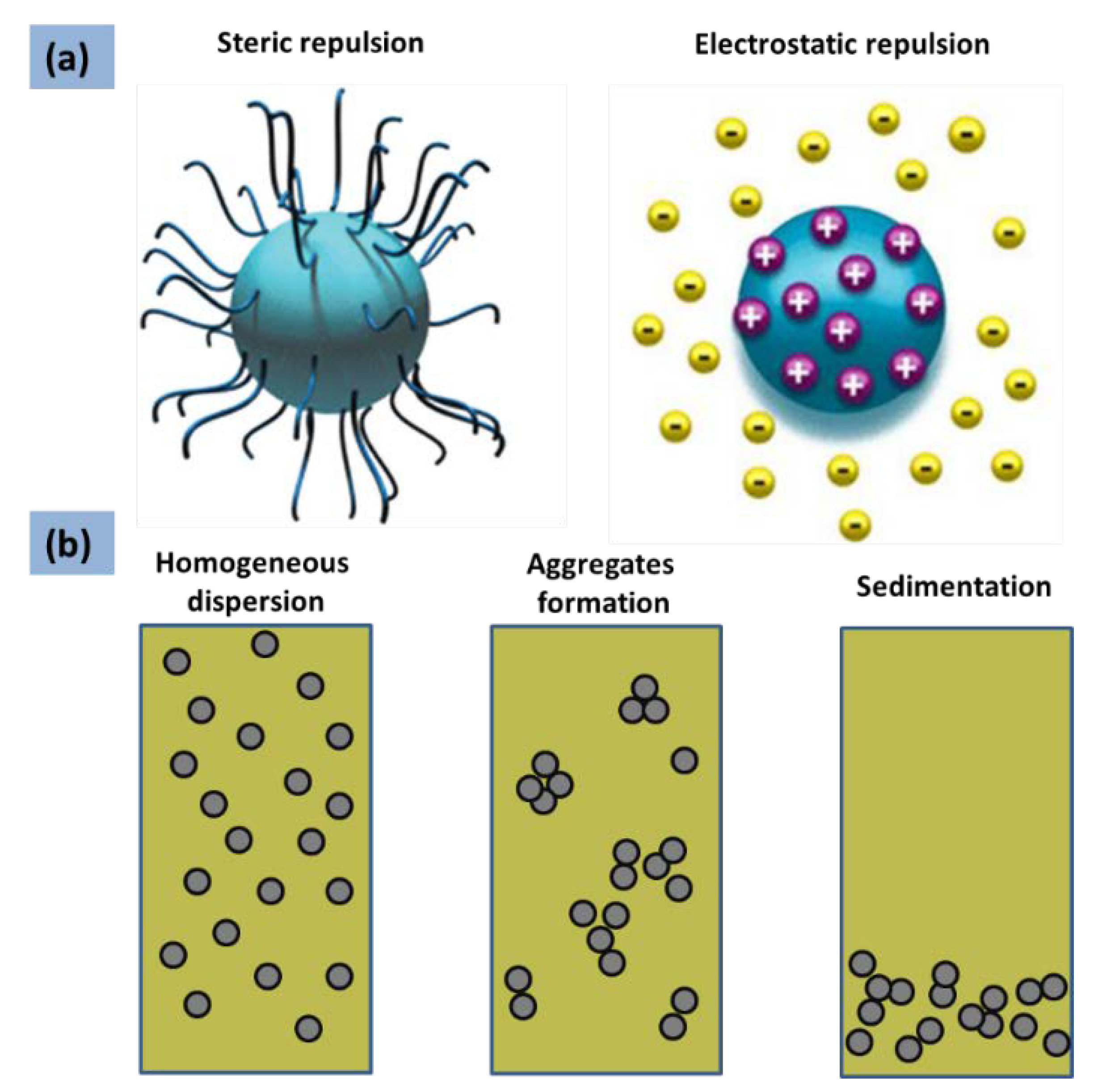
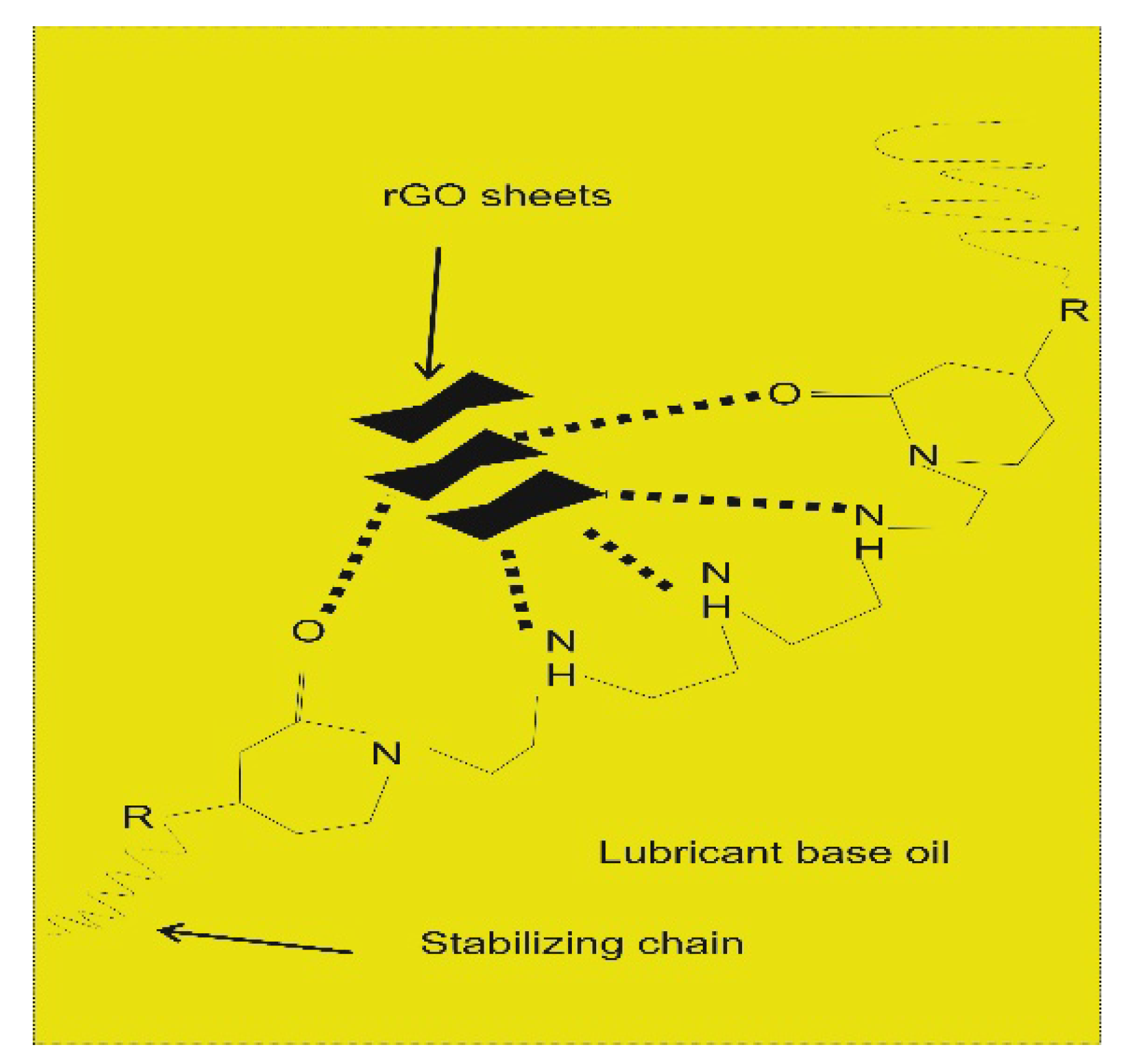


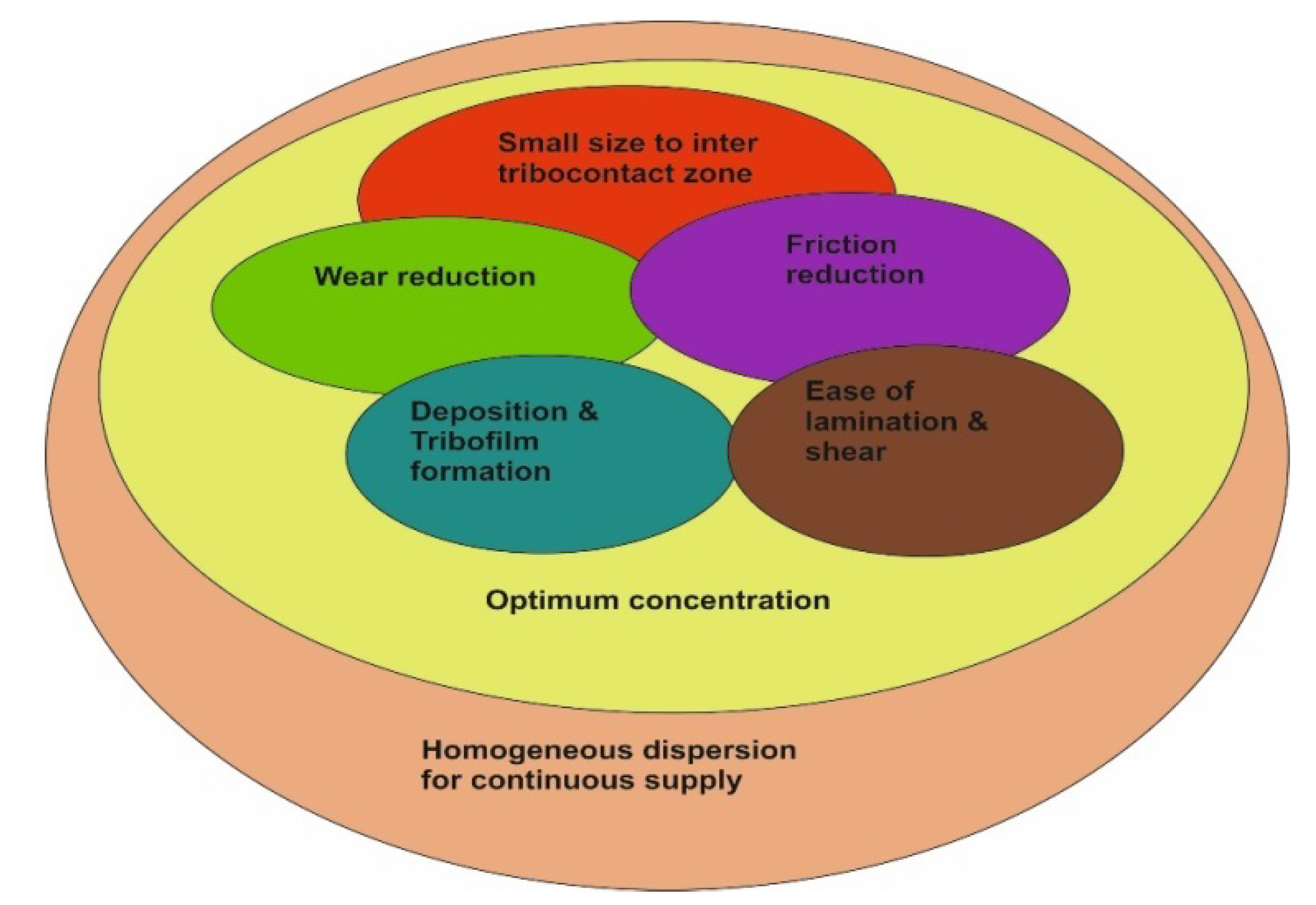
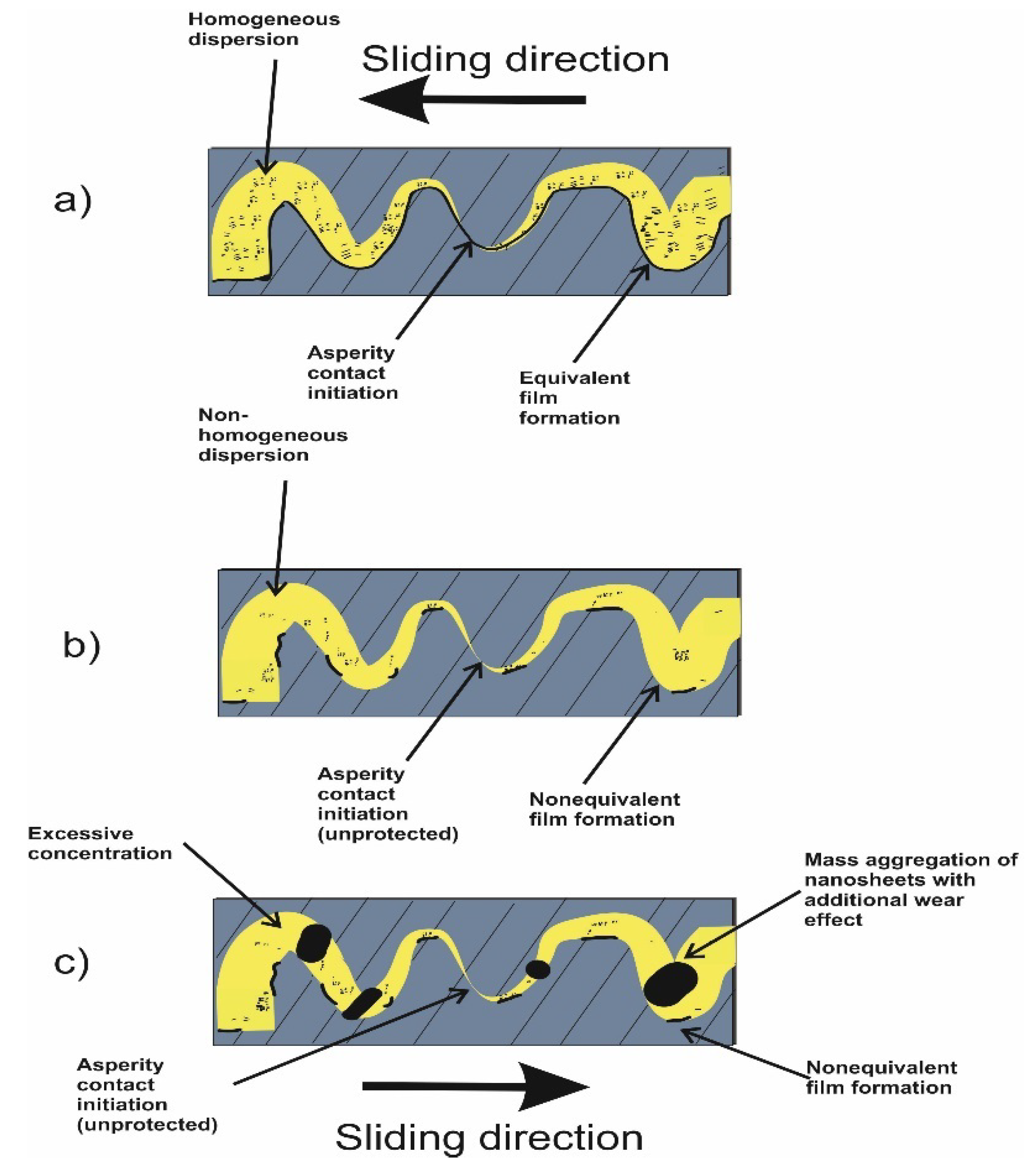
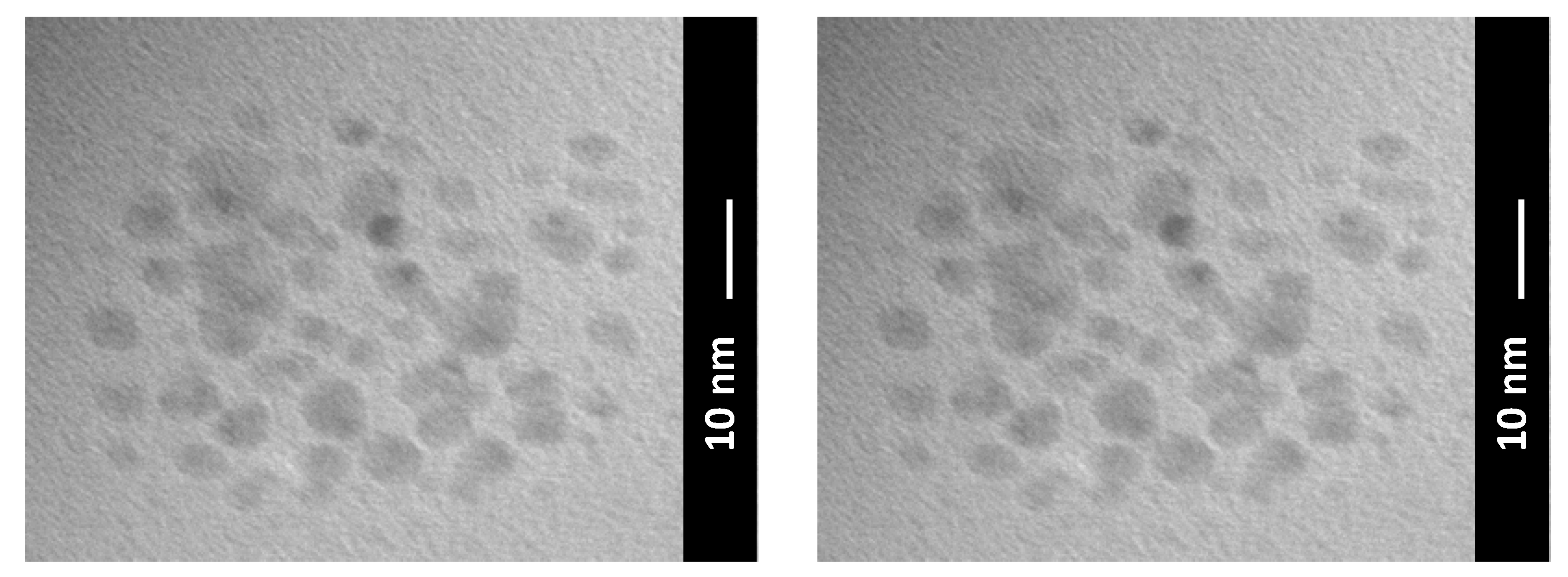
| Ref. | Year | Method of Stabilization | Optimum Concentration | Lubricant Oil | Stability | Tribometer | Load | Speed | Temperature/Time | Wear Reduction | Friction Reduction |
|---|---|---|---|---|---|---|---|---|---|---|---|
| [67] | 2017 | Mild thermal reduction of GO achieved by treatment at 700 °C | 0.5 wt% | Base oil PAO 6 | 25 h | Ball-on-disc | 2 N | 24 rpm | NA/1.5 h | Positive effect | 30% |
| [68] | 2017 | Covalent functionalization with organic moiety * | 0.01 wt% | Base oil (type NA) | 1 month | 4-ball | 400 N | 1200 rpm | Room/1 h | 30% | 16% |
| [56] | 2015 | Basal plane modification with octadecylamine * | 0.02 mg mL−1 | Commercial engine oil 10W-40 | 1 month | Standard steel balls reciprocating ball-on-disc | 100 mN | Micro: 1 cm s−1; standard: 3 cm s−1 | Room/1 h | 25% | 25% |
| [20] | 2011 | Stearic and oleic acids (mass ratio 3:5) modification | 0.075 wt% | Base oil SN350 | NA | 4-ball | 147 N | 1200 rpm | 75 ± 2 °C/1 h | 0.8–0.3 | 0.15–0.12 |
| [52] | 2011 | Modification with oleic acid | 0.02–0.06 wt% | Base oil PAO9 | NA | 4-ball | 400 N | 1450 rpm | Room/NA | 14% | 17% |
| [53] | 2014 | Amide linkage for octadecylamine defects edges sites modification * | 0.02 mg mL−1 | commercial engine oil (10W−40) | 1 month | 4-ball | 392 N | 1200 rpm | 75 °C/1 h | 26% | 9% |
| [69] | 2015 | Use of a dispersant: poly isobutylene succinic imide in oil | 0.5 wt% (used) | API Gr I and II + linear alkyl benzene | 1 year | Block-on-ring | 900 N | 1125 rpm | 50–110 °C/3 h | Positive effect | 0.07–0.02 |
| [70] | 2018 | Use of a surfactant: oleic acid | 0.4 wt% | A5 (5W−30) | NA | Setup: bench of ring line (reciprocation) | 9–368 N | 0.154-0.6 m/s | Room/NA | 22%–29% | 29%–35% |
| [71] | 2016 | Graphene balls formation by using an aerosol capillary compression approach | 0.01–0.1 wt % | Base oil PAO4 | 20 h | Pin-on-disk/boundary regime | 10 N | Linear sliding (10 mm/s) | Room/0.5 or 1 h | ∼85% | 20% |
© 2020 by the authors. Licensee MDPI, Basel, Switzerland. This article is an open access article distributed under the terms and conditions of the Creative Commons Attribution (CC BY) license (http://creativecommons.org/licenses/by/4.0/).
Share and Cite
Sarno, M.; Scarpa, D.; Senatore, A.; Ahmed Abdalglil Mustafa, W. rGO/GO Nanosheets in Tribology: From the State of the Art to the Future Prospective. Lubricants 2020, 8, 31. https://doi.org/10.3390/lubricants8030031
Sarno M, Scarpa D, Senatore A, Ahmed Abdalglil Mustafa W. rGO/GO Nanosheets in Tribology: From the State of the Art to the Future Prospective. Lubricants. 2020; 8(3):31. https://doi.org/10.3390/lubricants8030031
Chicago/Turabian StyleSarno, Maria, Davide Scarpa, Adolfo Senatore, and Waleed Ahmed Abdalglil Mustafa. 2020. "rGO/GO Nanosheets in Tribology: From the State of the Art to the Future Prospective" Lubricants 8, no. 3: 31. https://doi.org/10.3390/lubricants8030031
APA StyleSarno, M., Scarpa, D., Senatore, A., & Ahmed Abdalglil Mustafa, W. (2020). rGO/GO Nanosheets in Tribology: From the State of the Art to the Future Prospective. Lubricants, 8(3), 31. https://doi.org/10.3390/lubricants8030031






